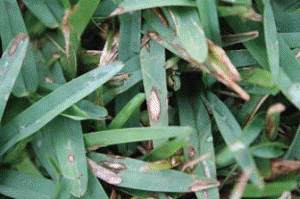Field turf can be hard to manage. Constant foot traffic, diseases, drainage and irrigation are all a part of the struggle. The first step is to identify it, then you’re on a road to healthier turf.
1. Soil Compaction
CAUSE: Foot traffic.
SYMPTOMS: Includes increased surface hardness, ball roll and bounce; poor growing conditions for turfgrasses; and inadequate drainage.
SOLUTION: Maintenance practices such as routine and effective soil cultivation need to be implemented to grow healthy turf. Cultivation can be preformed mechanically although may require soil amendment with sand or compost in extreme cases.
2. Poor Grade on Infields
WHAT: A field’s grade is the underlying factor that dictates the success or failure of the playing surface, since poor grades cause major problems with puddles and soil erosion.
CAUSE: Poor construction and maintenance.
SYMPTOMS: Poor grades lead to poor growing conditions for turf, to soil compaction issues, and commonly to canceled games and loss of revenue. The crown and a sloped grade on a field influence the movement of soil and water on a field. To high or too low can cause erosion, slow/fast water movement, and puddling.
SOLUTION: Make sure your field is at a proper grade. Consider different factors such as sand-based fields vs. naive fields when determining the proper grade. Invest the most money during renovations in grading. Also, have an infield laser-graded every few years.
3. Poor Drainage
CAUSE: Weak soil cultivation and topdressing program.
SYMPTOMS: Puddling.
SOLUTION: Keep a field’s saturated hydraulic conductivity values between 1 and 2 inches per hour. Establish this by maintaining sufficiently high sand contents in the rootzone, typically ~75 percent by weight. Preform modifications with sand by blending the entire rootzone on or off-site, installing sand slits/bands into the existing native soil, installing a sand cap, or topdressing with sand each year as part of the annual maintenance program.
4. No Irrigation
WHAT: No irrigation to get through dry times and periods of intense use.
CAUSE: Turf that is under watered cannot recover from sports traffic or grow new grass.
SYMPTOMS: Uncomfortable for athletes to play on, dryness, brown or dead spots, and hot grass.
SOLUTION: Use an irrigation system such as Rain Bird rotors. Irrigation will maintain turf growth and recovery; encourage new seeds, sprigs, plugs and sod; lower canopy temperatures during intense heat stress; water-in fertilizers and pest control products; soften hard and compacted surface playing conditions on native soil fields; produce firm, fast playing surfaces on sand fields; and control dust on baseball and softball fields. Choose a grass that works well in your specific area for best results. Consider using growing blankets, applying wetting agents, raising mowing heights, and applying irrigation early in the morning.
5. Using Annual Bluegrass
CAUSE:One of the most widely used grasses. Although, it has shallow roots, light green color and sensitivity to heat and drought make it unsuitable for sports field use.
SYMPTOMS: Light splotches and dies easily.
SOLUTION: Only use bluegrass in environmental conditions with compacted soils, moist soils, low mowing heights and moderate to high fertilizer use. Use cultural control methods such as handpicking, avoiding soil disturbance during peak germination in the fall, judicious use of water and fertilizer and regular over seeding with desirable grasses.
6. Prostrate Knotweed
CAUSE: High traffic areas in a field and prospers in soil compaction.
SYMPTOMS: Spreads and takes over a sports field. Brown splotches that are commonly mistaken for crabgrass.
SOLUTION: Control this by performing regular soil cultivation to relieve bulk density and to aggressively over seed, sprig or sod to maintain 100 percent grass cover. Use herbicides to prevent.
7. Summer Diseases
CAUSE: Applying fertilizer and water liberally increases the likelihood of developing in new areas. Not having implemented a fungicide program will also cause.
SYMPTOMS: Brown patches and fuzz.
SOLUTION: Choose to either use fungicide-coated or Apron-treated seed, or to apply a liquid or granular fungicide at the time of seeding. Water and fertilize carefully.
8. Gray Leaf Spot
 CAUSE: Caused by the pathogen Pyricularia grisea (Magnaporthe grisea) is a serious disease of both cool and warm-season turfgrasses.
CAUSE: Caused by the pathogen Pyricularia grisea (Magnaporthe grisea) is a serious disease of both cool and warm-season turfgrasses.
SYMPTOMS: Water-soaked lesions, twisted leaf tips, spreads quickly without treatment. Appears similar to severe drought stress, scorched look.
SOLUTION: Choose cultivars with improved genetic resistance, and be careful with irrigation and fertilizer applications during times that are most favorable for the disease to occur. Be sure to also mow in the morning or brushing to remove dew, improving air circulation with portable fans, and careful use of plastic rain tarps are all important factors. Fungicide applications should begin prior to the onset of disease and continue every one to three weeks as needed when warm, humid weather prevails. The extent of disease pressure will greatly influence fungicide performance.
9. Spring Dead Spot
WHAT: Spring dead spot is a disease that attacks the roots and rhizomes of bermudagrass turf, therefore any remediation work done in early spring needs to be carefully administered so as not to further stress the turf.
CAUSE: Aggressive verticutting and fungi.
SYMPTOMS: Circular patches of grass that do not come out of winter dormancy. These patches then collapse and leave sunken areas of dead turf that adversely affect the safety and play-ability of fields. Dieback, or the root system dying rapidly.
SOLUTION: Choosing bermudagrass cultivars with improved resistance and maximizing soil health by alleviating soil compaction, improving soil drainage, controlling thatch and maintaining a soil pH under 7.0. Also, providing the turf with light applications of nitrogen in the fall and two fall applications of potassium, which has been shown to reduce spring dead spot damage.
10. White Grubs and Billbugs
CAUSE: Drought conditions, thatch control.
SYMPTOMS: Billbug or white grub.
SOLUTION: Grow different grass if it is a consistent issue. It is key to maintain thatch control and to grow turf with deep, healthy roots, since grubs chew through the roots as they consume organic matter. Wait until these pests have been confirmed to be present before utilizing a chemical approach.
No matter the disease or cause, remember that all turf can be repaired. By taking precautions and creating a strict management style, turf will remain overall healthy. Keep these top ten turf struggles in mind when managing a field.











